Tag Archives: BOEM
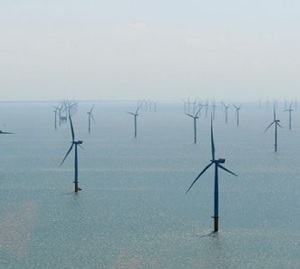
1,500 Wind Turbines. 2,700 Square Miles. Atlantic Offshore Wind Farms Will Be Big.
American offshore wind farms, (built of foreign components) of which there are 17 in the works for the Atlantic Ocean, are no longer far off on the horizon. Dire predictions of climate change and how to most quickly pivot to clean energy have fueled the embrace of offshore wind. And while most stakeholders seem on board with the nearly Eiffel Tower-sized turbines, the fishing industry remains a holdout. Meanwhile, the cumulative effect of so many turbines spread across the Mid-Atlantic Bight remains unknown. The bight stretches from the Outer Banks of North Carolina to the Gulf of Maine. video, notable quotes, >click to read< 10:50
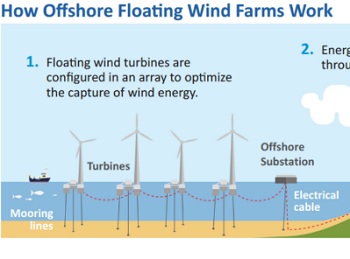
Maine Fishermen oppose offshore wind as alternative energy option – Support LD 101
“There’s so many different reasons to oppose it,” said Jack Merrill, a resident of Mount Desert and a member of the Cranberry Isles Fishermen’s Co-op,,, In an effort to meet Maine’s requirement of 80 percent of the state’s electricity from renewable sources by 2030 and the goal of 100 percent by 2050, there is a project being proposed to research offshore wind energy by installing up to 12 floating wind turbines in a 16-square-mile area, 20-40 miles off the coast. “By removing thousands of acres of bottom from fishing access, these turbines threaten the economic health of Maine’s second largest industry,,, >click to read< 13:48
Morro Bay: Fishing Industry Opposes New Floating Wind Farm Project Area – Tom Hafer, president of the 90-member Morro Bay Commercial Fishermen’s Organization, criticized the proposal, saying it amounted to a “bait and switch.” >click to read<

Vineyard Wind Withdraws From Federal Permitting Process
The first announcement that Vineyard Wind would withdraw from federal review was buried in a public statement that went out Dec. 1 about the company’s selection of General Electric’s Haliade-X as its preferred wind turbine generator model. Vineyard Wind is a joint wind energy venture between Copenhagen Infrastructure Projects and Avangrid Renewables. The process had seen repeated delays and slowdowns, but had nearly reached the finish line late last month, with the Bureau of Ocean Energy Management (BOEM) expected to release a final environmental impact statement by Jan. 15, five days before President Trump leaves office. Now Vineyard Wind appears to be betting on the Biden administration for a fresh start. >click to read< 08:40
(Vineyard Wind 1 Project) is no longer necessary and the process is hereby terminated– >click to read<
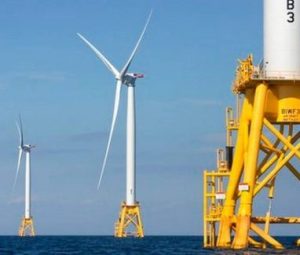
Progress expected for Rhode Island’s offshore wind farm plan
Much was made of the Raimondo administration’s selection in 2018 of a proposal for a massive offshore wind farm off the Rhode Island coast that would power as much as a quarter of the state’s electric load. But a Biden presidency is expected to boost renewables overall, and a decision could come in a matter of weeks for the benchmark Vineyard Wind project,,, A favorable ruling on the proposal could break the logjam for Revolution Wind. Orsted and Eversource are gearing up,,, >click to read< 09:21

Trump Administration ‘Slow-Walking’ Offshore Wind Permits says Sheldon Whitehouse
Sen. Sheldon Whitehouse, Democrat of Rhode Island, has accused the Trump administration of “slow-walking” offshore wind approvals with an eye toward helping natural-gas suppliers. (gas works, and its domestic!) The U.S. offshore wind industry, which is gearing up fantasizing to deliver 25 gigawatts or so of capacity over the coming decade, is effectively on hold while the country’s first major project, the 800-megawatt Vineyard Wind sited off the coast of Massachusetts, awaits its final federal permits. Last August the Interior Department’s Bureau of Ocean Energy Management (BOEM) called for additional environmental reviews, delaying Vineyard and in effect the larger industry as a whole. BOEM has said it intends to issue a final decision in December. “I think what we’re seeing is a deliberate slow-walk, and not just staff unfamiliarity and hesitation [at BOEM],” Whitehouse said in a prerecorded interview played Monday at Greentech Media’s Power & Renewables Summit. >click to read< 09:56
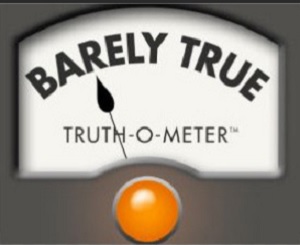
Vineyard Wind sails forward!
Atlantic waters 14 miles south of Martha’s Vineyard are again poised to be the site of a milestone that potentially rivals Pennsylvania’s Oil Creek Valley in U.S. energy significance. The Responsible Offshore Development Alliance (RODA), an advocacy group for fishing interests, along with other fishing organizations, has pushed for four-mile-wide transit lanes through the turbines for safe mobile gear fishing and safe general navigation. In general, fishermen have been the strongest critics of the project. “Vineyard Wind alone will generate at least 3,600 jobs, and reduce costs for ratepayers by an estimated $1.4 billion, according to the Massachusetts Department of Energy Resources,” the letter states. >click to read< 10:57
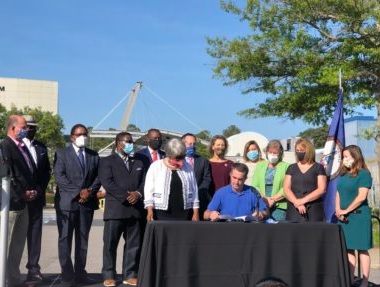
Dominion debuts first offshore wind farm in U.S. federal waters
Gov. Ralph Northam joined state and local officials, industry representatives and stakeholders Monday for a boat excursion 27 miles off the coast to take an up-close look at the massive turbines. Before embarking on the tour, Northam signed landmark offshore wind legislation during a ceremony in front of the Virginia Aquarium & Marine Science Center in Virginia Beach. He said the legislation will continue to position Virginia as a national leader in offshore wind development as the state builds a new industry with thousands of clean energy jobs. >click to read< 12:09
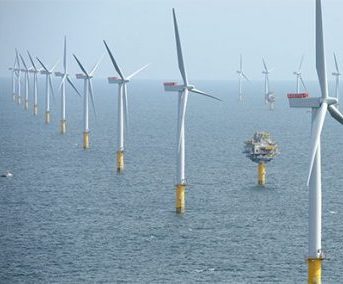
Here you go, Fishermen. Feds see 2,000 East Coast turbines over 10 years
The U.S. Department of the Interior’s Bureau of Ocean Energy Management (BOEM) this week issued a supplement to its draft Environmental Impact Statement (EIS) for the 800-megawatt Vineyard Wind I project, a joint venture of Copenhagen Infrastructure Partners and Avangrid Renewables seeking to build an 84-turbine wind farm 15 miles south of Martha’s Vineyard. A 45-day public comment period begins Friday. “This supplement analyzes reasonably foreseeable effects from an expanded cumulative activities scenario for offshore wind development, previously unavailable fishing data, a new transit lane alternative, and changes to the proposed Vineyard Wind 1 Project,” the document says. >click to read< 10:06

Offshore wind to have major ‘adverse’ effects
Offshore wind farms could have a major “adverse” impact on commercial fisheries, according to a long-awaited analysis from the Interior Department released yesterday. The Bureau of Ocean Energy Management’s draft supplemental environmental review for Vineyard Wind, the first anticipated large-scale wind project in the United States, arrives nearly a year after a final decision on the project was expected. BOEM delayed a final environmental analysis at the eleventh hour last summer and announced the launch of the supplemental review, arguing that the rapid expansion of offshore wind proposals and coastal state wind procurement policies necessitated a broader examination of wind’s foreseeable impacts >click to read< 14:37
RODA Receives NMFS Grant to Convene State of the Science Symposium on Fishing and Offshore Wind Interactions – The Responsible Offshore Development Alliance (RODA) has received a $150,000 grant from the National Marine Fisheries Service (NMFS) to aggregate existing knowledge, then convene a first-of-its-kind symposium on the current science regarding fisheries and offshore wind interactions. The project, “Understanding the State of the Science,” will advance agency, fishing industry, offshore wind energy developer, and public understanding of existing research on interactions between the two industries. >click to read<
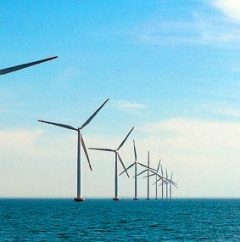
Energy policy plan first, then offshore wind if needed – Offshore wind project needs to be vetted in NH
Here are two offshore wind farm opinion pieces in the media written by New Hampshire fisherman David Goethel. Energy policy plan first, then offshore wind if needed – With the presidential primary and annual town meetings in the rearview mirror, Seacoast residents can set their sights on the next big public policy debate. A massive wind energy facility often referred to as wind farms may be built off the coast of New Hampshire and residents will have to carefully weigh the pros and cons of this undertaking. From previous articles in Seacoast papers, it is obvious that both the political structure and the public have very little understanding of the facts surrounding this construction. >click to read< Offshore wind project needs to be vetted in NH – If you read last week’s column, you know I called on Congress to task the National Academy of Science with producing a comprehensive energy policy. One question they would answer would be why we need to construct a wind energy facility off New Hampshire when Hydro-Quebec has an enormous surplus of renewable energy going unused because no transmission line has been built to New England. Readers should ask politicians and environmentalists the same question. Meanwhile here are some facts about what is proposed for our shores. >click to read< 19:57

New England: Fishing Industry and offshore windfarmers no closer to finding solutions
The National Marine Fisheries Service and the National Oceanic and Atmospheric Administration, had refused to endorse BOEM’s draft EIS for Vineyard, complaining that fishing concerns were not addressed adequately. This helped trigger the government’s ongoing analysis of offshore wind’s cumulative impacts in the region.,, In public comments on the USCG port-access study, Meghan Lapp, fisheries liaison for frozen fish supplier Seafreeze, a subsidiary of Spain-based conglomerate Grupo Profand, called for the lanes.,, Lapp also called for an assurance of maritime safety that she said would be compromised by radar interference from wind turbines. >click to read< 08:34
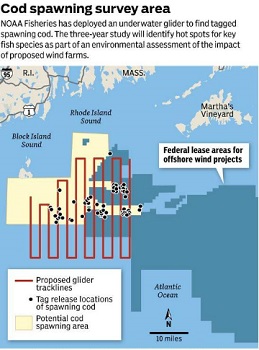
Federal study surveys spawning Atlantic Cod – Research area sits in waters zoned for offshore wind projects.
NOAA, the state Division of Marine Fisheries, Woods Hole Oceanographic Institution and the University of Massachusetts Dartmouth School of Marine Science and Technology are all participating in the study, which is funded by the U.S. Bureau of Ocean Energy Management. The research is focused on what may be one of the last remaining major seasonal spawning gatherings in the Northwest Atlantic, according to the state Division of Marine Fisheries. “It’s certainly been a persistent spawning aggregation and there are not many in New England,” said fisheries scientist Steve Cadrin, principal investigator on the project for the School of Marine Science and Technology. Atlantic cod populations are at historic lows, hammered by chronic overfishing and climate change. >click to read< 07:06

A fowl wind blows offshore
With the increased science available, showing a variety of impacts, The BOEM (Bureau Of Ocean Energy Management) Lease schedule through 2024 within the Department of Interior should be reevaluated. Since there is no official BOEM Atlantic, director, or administrator that has ever been permanently appointed, the request for a Atlantic review has not been initiated. A reliance on the bidders financial review of the lease sites is how BOEM is determining the viability for development. ( A buyer beware mentality ). This policy is a mistake and is costing the taxpayers millions. Brick Wenzel >click to read< 21:17

Vineyard Wind to Miss Startup Target Over Permit Delay
“While we need to analyze what a longer permitting timeline will mean for beginning construction, commercial operation in 2022 is no longer expected,” Vineyard Wind Chief Executive Lars Pedersen said in a statement. Vineyard Wind is a joint venture between Copenhagen Infrastructure Partners and Avangrid Inc. >click to read< 06:12

For offshore wind, expect more delays, review won’t be done until December
The Vineyard Wind project was put on hold indefinitely in August 2019 when the federal government decided to supplement its environmental impact review with a study of the cumulative impact of the many wind farms being proposed along the eastern seaboard. The impact of wind farms on fishermen is a focus of that supplemental review. >click to read< 14:19

Federal review of offshore wind projects raises concerns over delays
The Trump administration’s unexpected review of “potential impacts” of offshore wind-energy projects could be published early this year, but it remains unclear whether publication will clear a logjam that has stalled one of the country’s first large-scale projects, and the dozen to follow.,,, Last year, when the Bureau of Ocean Energy Management announced an analysis of offshore wind projects slated for construction in U.S. waters, Vineyard Wind, the first affected by it, was caught off guard. Vineyard Wind is proposing a project off the Massachusetts coast. >click to read< 07:31
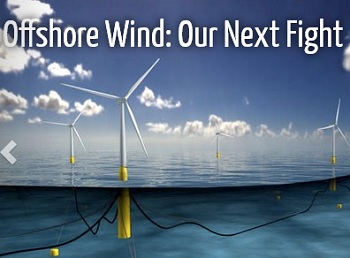
Terra-Gen Critics Said We Should Wait for Offshore Wind, But Will That Project Spark an Even Nastier Debate?
Last month, under intense public pressure, the Humboldt County Board of Supervisors rejected the $300 million Humboldt Wind Energy Project, bringing a dramatic end to the most polarizing countywide policy debate this community has seen in years.,, But if anyone thought we could sidestep controversy by moving wind energy proposals from land to sea, well, think again. In conversations with the Outpost, local and regional stakeholders expressed serious concerns about a range of issues, including conflicts with the fishing industry, impacts to birds and marine life and more. FIGHT! >click to read< 10:42

Seabrook: New Hampshire Fishermen deserve voice in offshore wind plans
Selectmen are abandoning a task force looking at offshore wind turbines in the Gulf of Maine, demanding their local fishermen have more direct inclusion.,, Fishing communities like in Seabrook have expressed strong concerns about the turbines’ impact on the ocean and the fish they harvest for a living.,, They said in their letter to the OSI they wanted fishermen to have a direct seat on the task force, which is comprised of elected officials from New Hampshire, Massachusetts and Maine. >click to read< 18:08
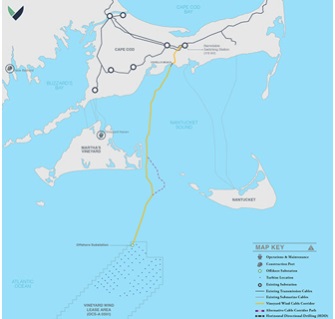
Offshore Wind Awaits Federal Environmental Reports
The latest industry initiative is the expansion of a cable factory in Charleston, S.C., where Paris-based Nexans plans to make some 620 miles of high-voltage power lines for the five wind projects under development by the utility Eversource and Danish energy company Ørsted. The companies declined to say how the five-year contract was granted. Nexans is also building a new cable-laying vessel with a 10,000-ton capacity.,,, The report was quickly criticized by representatives from the squid and scallop industry who said the 1-mile spacing between the turbines doesn’t improve safety and the layout restricts fishing. “This is the biggest screwup to hit our oceans ever,” said Dellinger, who is chairman of the Rhode Island Fishermen’s Advisory Board. >click to read< 16:58
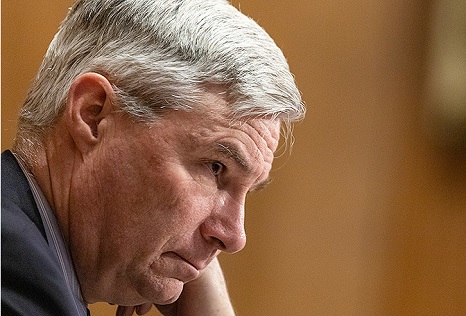
Top climate hawk bashes first big offshore wind project. Sheldon??
For the past seven years, Sen. Sheldon Whitehouse has given a weekly address about the dangers of climate change. Increasingly, some greens wonder if he is full of hot air. The Rhode Island Democrat, one of the Senate’s top climate hawks, has emerged as a leading critic of Vineyard Wind, an 84-turbine offshore wind project proposed in federal waters 15 miles south of Martha’s Vineyard.,,, Whitehouse’s statements echo concerns of Rhode Island squid fishermen, who have emerged as leading opponents of Vineyard Wind. >click to read< 12:21

Trump aide offers no guidance on Vineyard Wind
The Bureau of Ocean Energy Management put the offshore wind farm on hold indefinitely in early August while it tries to gain a better understanding of the cumulative impact of the many East Coast wind farm projects currently in the pipeline. With the project in danger of being canceled if the delay lasts too long, James Bennett, the renewable energy program manager at the Bureau of Ocean Energy Management, gave no indication of when the agency’s review will be completed. >click to read< 08:33

Offshore Wind Energy Looks More Promising for Oregon
A stretch of the Pacific Ocean off the coast between Humboldt County, California, and Coos Bay, Oregon, has some of the highest wind power generating potential in the country. The area north of the California border looks particularly promising to green energy advocates because the region already has a functioning electric grid. But a past attempt to install five floating turbines off Coos Bay faced rising costs and opposition from the fishing industry, and was eventually moved to California when no one could be found to buy the high-priced power the facility planned to generate. >click to read< 11:24
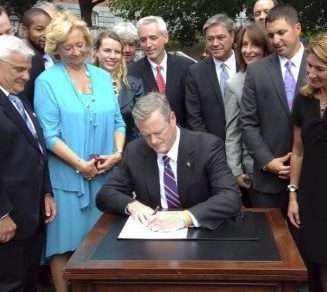
“We don’t even know what the rules of the road are,” Fishermen unsatisfied with wind turbine plans
Rhode Island commercial fishermen sat down a year ago with offshore wind developers, they say they made it clear that for the sake of navigational safety the minimum spacing of any turbines installed in ocean waters needs to be at least one nautical mile in every direction.,,,“It’s the exact thing we’ve been saying for years,” said Lanny Dellinger, the Newport lobsterman who chairs the board. “That’s the minimal ask for us.”,,,In Rhode Island, representatives of Ørsted were conciliatory and the meeting was generally cordial, but at the heart of the discussions over the South Fork project is a larger clash between two industries, one legacy and the other nascent,,, >click to read< 07:46

Vineyard Wind Gasping for Air Until 2020
The Bureau of Ocean Energy Management has delayed the construction off our coast of Vineyard Wind, the country’s first commercial scale offshore wind farm, until 2020. I believe President Trump is squarely behind all the concerns of the commercial fishing industry that haven’t been adequately resolved by the wind farm folks, and if you don’t get the problems addressed now, as Carlos Santana would say, “you can forget about it.” Because five other offshore wind projects are planned adjacent to the site. Phil Paleologos >click to read< 19:58

Wind turbines and fishing nets fight for offshore space
Vineyard Wind,,, In 2010, BOEM launched an initiative dubbed “Smart from the Start,” which aimed to steer wind development away from prime fishing areas, shipping lanes and sensitive marine habitat prior to leasing.,,, New Bedford Mayor Jon Mitchell. “There are some squid fishermen, mostly from Rhode Island, and some lobstermen who fish in there, but the value of the area’s annual fish landings is modest, especially compared to the lease areas proposed off of New York.”,,, Also important: Few members of New Bedford’s scallop fleet fish in the waters off Massachusetts.,,,But if scallopers can live with offshore wind development off Massachusetts, others are vehemently opposed. Rhode Island fishermen trawl for squid in the area. >click to read< 09:19

Opinion: Responsible Offshore Development Alliance Statement on Vineyard Wind Federal Review Process
In light of the recent decision by the Bureau of Ocean Energy Management (BOEM) to perform a cumulative impacts analysis regarding the proposed Vineyard Wind project, and the recently released communications between that agency and the National Marine Fisheries Service (NMFS), RODA would like to clarify certain statements and representations. >click to read< 08:27






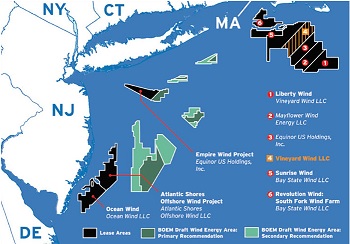
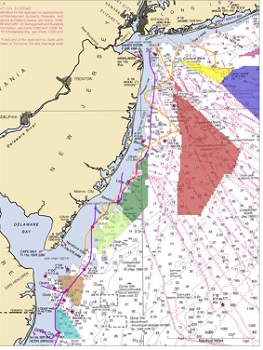



























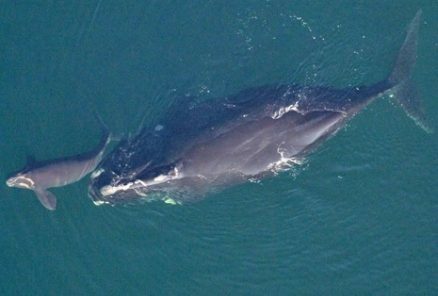
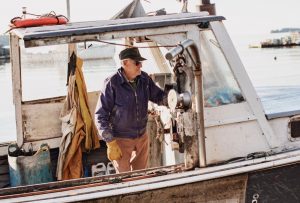
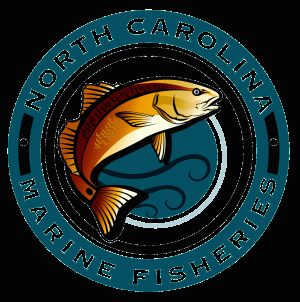



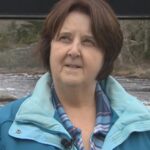
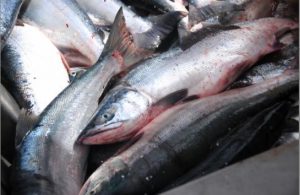



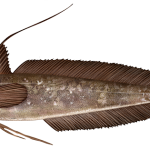

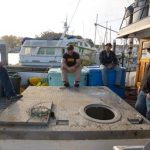
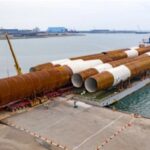



Public comments of residents and officials reiterate concerns about Ocean Wind offshore wind farm off Atlantic City
Rick Robinson likens the idea of building up to 98 wind turbines on the ocean horizon to placing them on the rim of the Grand Canyon.,,, Saying offshore wind farms will “forever reshape our Eastern Seaboard,” U.S. Rep. Jeff Van Drew, R-2nd, joined representatives of the fishing industry and tourism interests in asking for changes in the way wind farms are approved. “I have spoken with many fishermen, and they continue to feel disenfranchised in this process by both their government and the corporations that now own their established fishing grounds,” >click to read< 11:26
Share this post